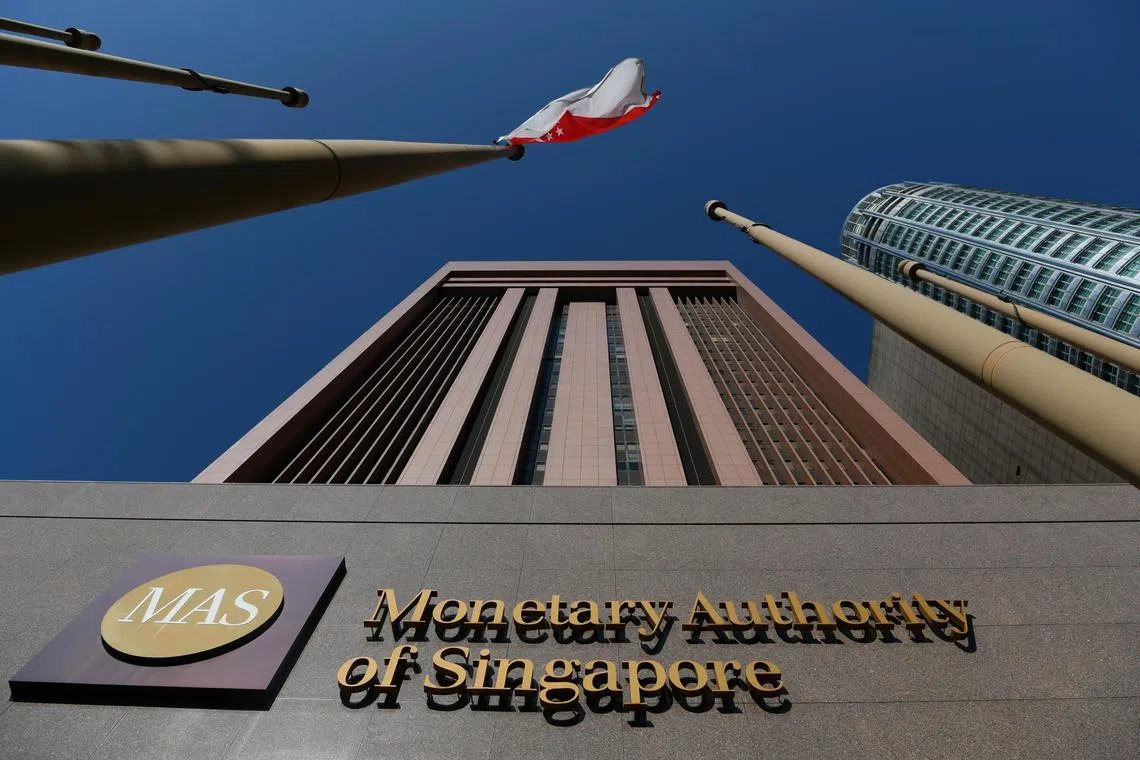Total outstanding debt arranged by financial institutions in Singapore down 2% in 2022: MAS
Sign up now: Get ST's newsletters delivered to your inbox

New debt issuances tumbled 18 per cent to $190 billion in 2022 from $232 billion in 2021.
PHOTO: ST FILE
Follow topic:
SINGAPORE - The total outstanding debt arranged by financial institutions in Singapore stood at $512 billion at the end of 2022, down 2 per cent from $523 billion in 2021, as major central banks raised interest rates to rein in inflation.
New debt issuances tumbled 18 per cent to $190 billion in 2022 from $232 billion in 2021, according to the Singapore Corporate Debt Market Development Report 2023 released by the Monetary Authority of Singapore (MAS) on Monday.
In Asia excluding Japan, the issuance volume of G-3 bonds – which represent bonds denominated in US dollars, yen or euros – halved to US$192 billion (S$263 billion) from US$391 billion in 2021.
The US dollar was the most favoured currency for corporate debt issuances in Singapore in 2022, accounting for 73.4 per cent of the currency denominations.
This was followed by the Singapore dollar at 15.3 per cent, the euro and the Hong Kong dollar at 2.6 per cent each, and the Australian dollar at 2.5 per cent.
Financial institutions were the key issuers in 2022. This was driven by banks’ funding activity to strengthen capital buffers in anticipation of further interest rate hikes by the US Federal Reserve.
Their share of Singapore dollar issuances stood at 44.3 per cent. Statutory boards accounted for 28.1 per cent of the share of Singapore-dollar issuances, corporates excluding properties and special purpose vehicles at 10.7 per cent each, and property firms at 6.2 per cent.
Financial institutions accounted for 83.9 per cent of the non-Singapore dollar issuances. Corporations excluding property comprised 10.8 per cent, special purpose vehicles 4.7 per cent, supranational 0.3 per cent and property 0.3 per cent.
“Financial institutions continued to tap our multi-currency bond market and raised funding in various currencies such as the US dollar, Australian dollar, yuan, Hong Kong dollar and euro in anticipation that funding costs were likely to rise further in the near term,” MAS said.
On the other hand, the number of corporate issuers halved in 2022, as those with strong balance sheets cut back on fund-raising efforts as borrowing costs increased.
Issuance of green, social, sustainability, sustainability-linked and transition bonds (GSS+) in Singapore fell to $10.1 billion in 2022 from $14.4 billion in 2021. However, this remained higher than the $8.6 billion worth of issuances for 2019 and 2020 combined, signalling “a continuing mainstreaming” of GSS+ bonds, MAS said.
In 2022, the Housing Board, National Environment Agency and national water agency PUB raised a total of $8.2 billion, half of which were green bonds.
The financial regulator said public sector green bond issuances are a key part of Singapore’s sustainability strategy and its efforts to develop the country as a green finance hub in Asia.
“These issuances spur the development of a high-quality green bond market in Singapore by serving as a reference for the corporate green bond market, deepening market liquidity for green bonds, attracting green issuers, capital, and investors,” MAS said.
The Singapore Government issued its inaugural $2.4 billion sovereign green bond in August 2022.
Real estate investment trusts, such as First Reit, Ascendas Reit and Ascott Reit, issued a total of $500 million of social, green and sustainability-linked bonds in 2022 as well.
Also of note was an offshore US$500 million green bond issued by the Singapore branch of Bank of China in April 2022 as part of its sustainability series of bonds issued in various jurisdictions. The proceeds were used to fund electrified metro projects and green building projects.
MAS said global financial conditions continued to be less accommodative, with interest rates expected to remain higher for longer in 2023.
It said that Asian bond markets would be driven by the refinancing needs of corporate issuers as interest rate conditions stabilise and, over the medium term, financing needs to support Asia’s net-zero transition.
“Singapore’s ecosystem of banks, investors, and professional service firms, as well as the digitalisation of bond market infrastructure, will support fund-raising efforts in the region and help channel international capital to support Asia’s growth and net-zero transition needs,” MAS said.
Year to date, the total volume of Singapore dollar-denominated issuances stood at $16.9 billion, compared with $21.3 billion in the same period last year, according to Bloomberg data.
Mr Wong Di Ming, research analyst of the bond research team at Bondsupermart, told The Straits Times that this was expected, given the challenging economic outlook. The higher interest rate environment had made it difficult for corporates to issue debt in 2023, notably in the first half of the year.
“We continue to expect fewer issuances overall for 2023, underpinned by our view of higher-for-longer interest rates,” he said.
Corporates are expected to continue to tap the larger US dollar debt market, which provides more options to choose from.
“That said, for investors who prefer to avoid foreign exchange risk, we recommend sticking to the currency they hold,” Mr Wong said.
The financial sector is expected to continue dominating debt issuances, given that banks benefit from the ongoing high interest rates. Banks are incentivised to raise capital through the debt market to provide for more loans, while at the same time tapping various sources of capital beyond the traditional deposits.


